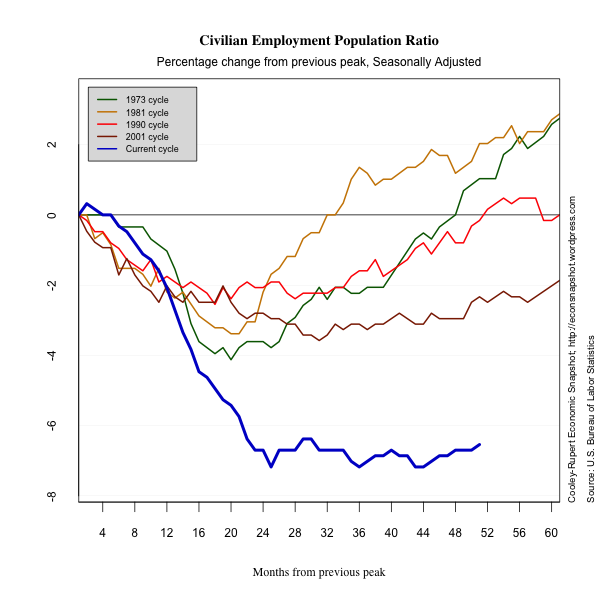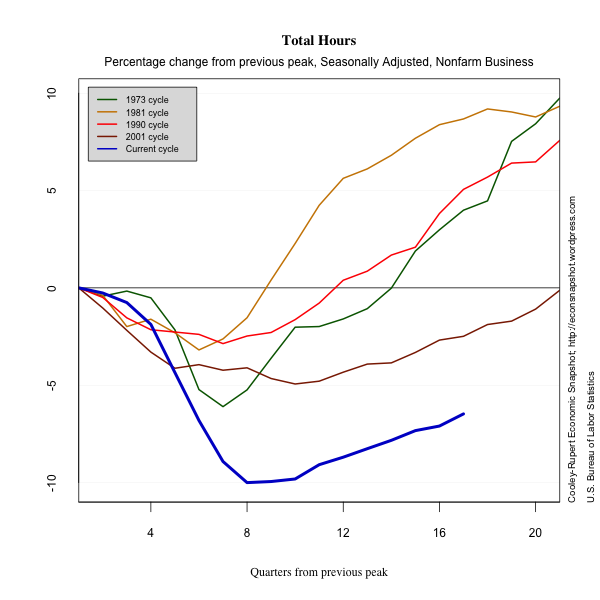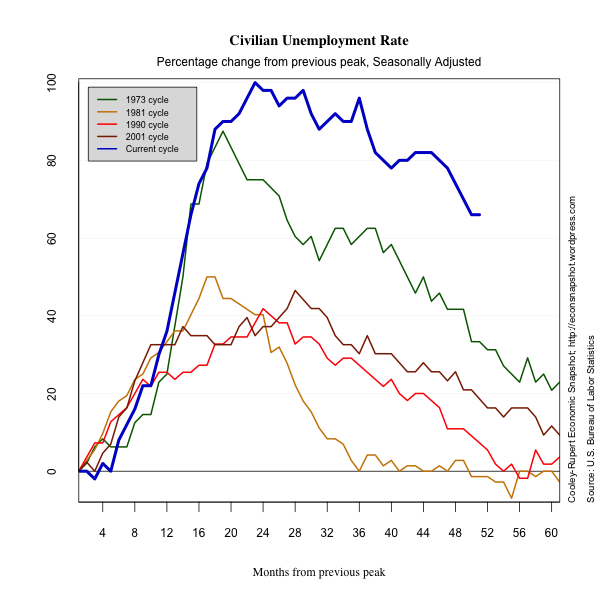Welcome to the Cooley-Rupert Economic Snapshot, our view of the current economic environment. This is the latest version of our snapshot of the U.S. Economy based on the new employment numbers released today by the Bureau of Labor Statistics. The complete Snapshot based on the latest revisions to fourth quarter GDP from the Bureau of Economic Analysis can be found in our previous post.
As in all of our snapshots we present the data in a way that we find particularly useful for assessing where we are in the business cycle and tracking the U.S. economic recovery. The paths of all the series presented are plotted relative to their value at the peak of the respective business cycles. We use the business cycle dates identified by the National Bureau of Economic Research.
You can also find the most recent version of the entire snapshot in pdf form here. As always we welcome any suggestions for additional data that you would like to see and suggestions for how to improve the presentation of the data.
The Labor Market
The latest Employment Situation report from the Bureau of Labor Statistics shows non-farm payroll employment rose by 227,000 jobs in February. Prior payrolls were revised upwards for January and December. These indicate a continued improvement in labor market conditions but at the same modest pace of recent months. The total number of unemployed remained essentially constant. This reflects the fact that labor force participation increased in February, perhaps an encouraging sign. The household survey showed an increase in labor force participation of about 0.2%, while participation declined through much of 2011. The new participants kept the number of unemployed at the same high level but the number of unemployed because of job loss declined. For comparison, as we did last month, we plot employment as reported by ADP, an association of payroll processors. Many observers view this as a useful early indicator of the BLS numbers.
Several indicators, however, suggest deeper problems in the labor market. The number of long term unemployed remained essentially unchanged this past month, and comprise more than 40% of the unemployed. The numbers of people who are involuntarily underemployed, marginally attached to the labor force and the number of people who classify as discouraged workers are essentially unchanged. These suggest the deeper malaise of the labor market is not being dented by the marginal job gains.
It is interesting to note where the jobs are being added. Employment increased in professional and business services, health care services and leisure and hospitality. There was a modest increase in manufacturing jobs. Most of the job growth seems to be in occupations that require more skills. However, perhaps due to still-cautious employers, although professional and business services added 82,000 jobs in February, just over half of the increase occurred in temporary help services (+45,000). There has been much anecdotal evidence that the skills mismatch in the U.S. economy is holding back a more robust recovery. The JOLTS Survey data for February will give us a better picture of that.
Aggregate Hours of work captures changes in both the extensive margin of labor force adjustment (employment), and the intensive margin (hours of work). Many believe this offers a more accurate picture of the economy. Hours continue to increase consistent with higher employment but average weekly hours has not changed.
Productivity continues to increase and unit labor costs have risen a little.










